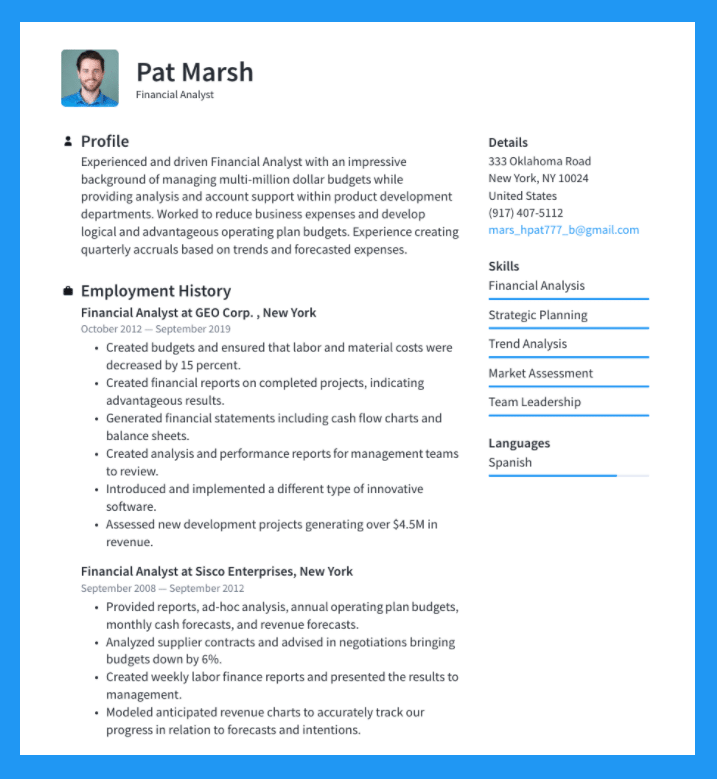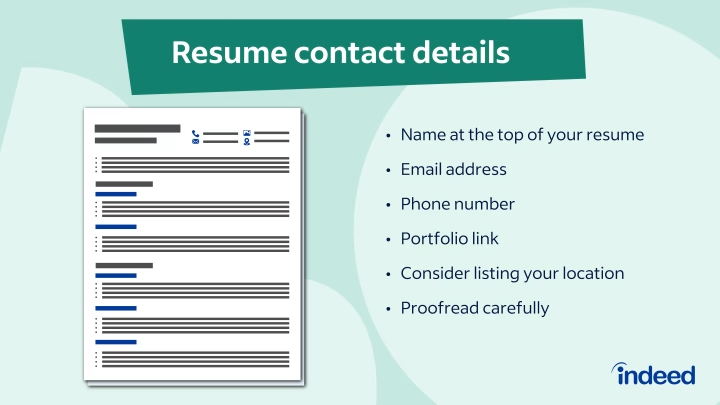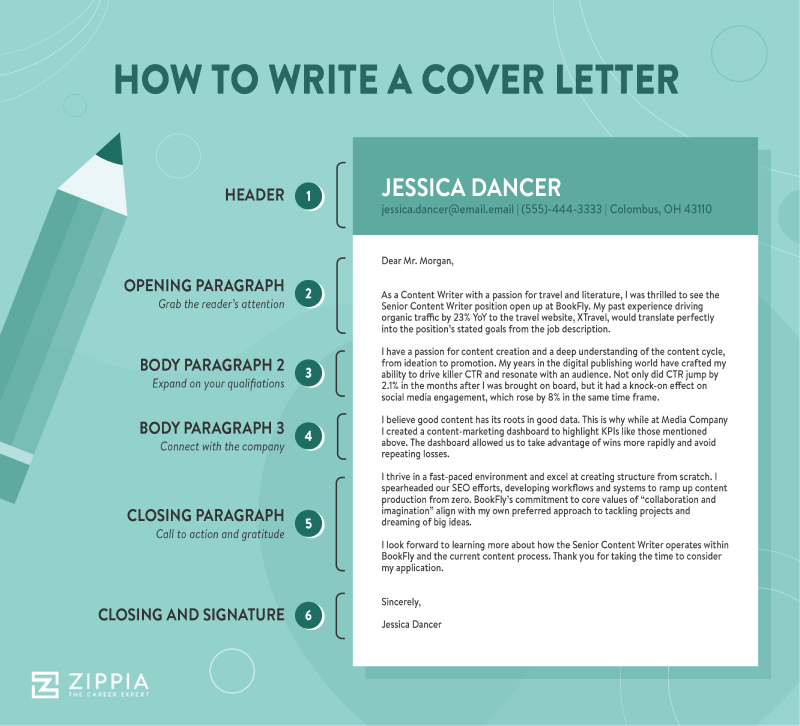Machine Learning Resume Template with Examples and Tips

Creating a great machine learning resume is your first step towards securing exciting career opportunities in artificial intelligence.
But writing a machine learning resume that stands out from the crowd requires some planning and thought.
In this blog post, we'll provide you with a valuable machine learning resume template, along with practical examples and expert tips to help you create the ideal resume that highlights your machine learning expertise.
By the end of this post, you'll be well on your way to building a machine learning resume that gets noticed by recruiters and hiring managers.
Tips for Writing a Machine Learning Resume
Before we share our machine learning resume template, let's go through some tips on how to write the perfect resume for machine learning.
Use Titles and Headlines Properly
You might be on the top of your field, but if your resume reads like a dense block of text, it risks getting lost in the pile of other resumes or it might leave the hiring manager feeling overwhelmed.
This is where resume headlines and titles come in.

You should think of your resume as a well-designed website or online blog post.
Just like clear headings and titles guide users through a website, they perform the same function on your resume.
By adding titles and headlines, you can break up the text, making it visually appealing and easier to scan for relevant information. This is crucial, especially for recruiters and hiring managers who might only spend a few seconds on each resume.
Examples of headers can include:
- Employment History
- Previous Experience
- Portfolio
- Bio/Introduction
Add Contact Information First
First impressions matter, and on your resume, that first impression starts with your contact information. Placing it at the very top of your resume ensures it's the first thing recruiters and hiring managers see.
This seemingly simple step can significantly increase your chances of landing an interview.
Here's why prioritizing your contact details is crucial:
- Accessibility: By putting your contact information first, you make it easier for potential employers to reach out. No more digging through your resume to find your email address – it's easily available, streamlining the communication process.
- Professionalism: A well-organized resume with clear contact details demonstrates professionalism and attention to detail. It shows you're prepared and ready to connect.
What Contact Information to Include:
- Full Name: This should be the most prominent element, formatted slightly larger and bolder than the rest of your contact details.
- Professional Email Address: Use an email address specifically for professional purposes. Avoid using nicknames or anything unprofessional.
- Phone Number: Include your preferred phone number for work-related calls. Opt for a number with a voicemail message that includes your name for a polished touch.
- Optional: Depending on your field and the job you're applying for, you might consider including a link to your professional website or LinkedIn profile.

Follow a Logical Layout
A well-organized resume with a logical layout is critical for showcasing your machine learning expertise in the best possible manner.
Here's a breakdown of a recommended layout for a machine learning resume:
- Header: This prime spot at the top of your resume should prominently display your contact information (as discussed previously).
- Summary/Profile: A concise summary statement or professional profile can be a powerful tool to grab the reader's attention and quickly highlight your key skills and experiences in machine learning.
- Work Experience: This section is the heart of your resume, showcasing your professional achievements and responsibilities. List your work experience in reverse chronological order, with your most recent position first. For each position, use clear headings with your job title, company name, and dates of employment. Within each role, leverage bullet points to describe your accomplishments, focusing on projects and tasks that demonstrate your machine learning skills.
- Skills: This section highlights your technical and soft skills relevant to machine learning. Here, you can list your programming languages (Python, R, etc.), machine learning frameworks (TensorFlow, PyTorch, etc.), data analysis tools (Scikit-learn, etc.), and other relevant skills like cloud computing or problem-solving.
- Education: List your academic qualifications in reverse chronological order, including your degree, institution name, and graduation year. You can also mention relevant coursework or projects completed during your studies.
- Projects: If you have completed personal machine learning projects, consider including a dedicated section to showcase your initiative and passion for the field. Briefly describe the project, your role, the tools and techniques used, and the achieved results.
- Additional Sections (Optional): Depending on your experience and the job you're applying for, you might consider including additional sections like certifications, awards, or publications to further strengthen your candidacy.
By following this logical layout, you create a resume that is easy to navigate and ensures your most relevant machine learning qualifications are presented in a clear and impactful manner.
Keep it Simple
Your machine learning resume should be a concise and to-the-point document that highlights your most relevant skills and experiences.
Here are some best practices to keep your machine learning resume short and to the point:
- One to Two Pages: Aim for a resume that can be effectively scanned and understood within one to two pages.
- Short Sentences and Bullet Points: Ditch lengthy paragraphs. Use concise sentences and strong bullet points to describe your achievements and responsibilities.
- Focus on the Most Relevant: Prioritize your skills and experiences that are most relevant to the specific job you're applying for. Don't feel obligated to include every single detail of your career history.
Add a Portfolio or Projects Section
While your work experience section details your past roles and responsibilities, a portfolio or projects section on your machine learning resume allows you to showcase your skills and achievements in a more tangible way.

This is your chance to shine a spotlight on your real-world application of machine learning concepts and principles.
Customize Your Resume for Each Job Application
When applying for a job in machine learning, you should customize your resume for each individual application.
Customizing your machine learning resume according to the specific job description not only demonstrates your attention to detail but also increases your chances of appealing to prospective employers and recruiters.
Look out for important keywords, industry-specific experiences, and desired skills outlined in the job description. And then emphasize these in your resume.
Summarize Your Machine Learning Resume
Your resume should not end abruptly.
A strong concluding paragraph, often referred to as a summary statement or career objective, serves as a powerful closing act, leaving a lasting impression on the recruiter.
Common Responsibilities Found on Machine Learning Job Descriptions
Here are some of the most common responsibilities that you'd find on a typical machine learning job description:
- Developing and implementing machine learning algorithms and models
- Conducting data analysis and interpreting results to drive decision-making
- Collaborating with cross-functional teams to integrate machine learning solutions into products or systems
- Improving model performance through optimization and tuning
- Researching and staying current on industry trends and advancements in machine learning
- Cleaning data to ensure accuracy and reliability of models
- Communicating complex technical concepts to non-technical stakeholders
- Participating in the design and architecture of machine learning systems
- Troubleshooting and debugging machine learning models and algorithms
- Ensuring data security and ethical considerations in machine learning applications
When applying for a new ML job, be sure to read through the job description for these responsibilities and then include how you have experience managing these responsibilities in your resume.
Machine Learning Resume Template
John Doe
[Phone Number] | [Email Address] | [LinkedIn Profile URL (Optional)]
Summary
Highly motivated and results-oriented Machine Learning Engineer with 3+ years of experience developing and deploying machine learning models to solve complex business problems. Proven ability to leverage various machine learning techniques and frameworks to achieve high accuracy and performance. Skilled in data pre-processing, feature engineering, model optimization, and effective communication of technical concepts to stakeholders. Eager to contribute expertise in natural language processing (NLP) and computer vision (CV) to a fast-paced and innovative company.
Work Experience
Machine Learning Engineer | ABC Tech Solutions | May 2021 - Present
- Developed and deployed a sentiment analysis model using NLP techniques to analyze customer reviews, resulting in a 20% improvement in customer satisfaction ratings.
- Designed and implemented a computer vision system for product defect detection, leading to a 15% reduction in production line errors.
- Built and maintained a machine learning pipeline for real-time fraud detection, achieving a 98% accuracy rate.
- Collaborated with cross-functional teams (data scientists, software engineers) to ensure successful integration of machine learning models into production systems.
- Documented and presented machine learning projects to technical and non-technical audiences.
Data Analyst Intern | XYZ Inc. | June 2020 - August 2020
- Performed data cleaning, exploration, and feature engineering for various machine learning projects.
- Assisted in building and evaluating predictive models using Python libraries like Scikit-learn.
- Communicated data insights and model performance metrics to senior data scientists.
Skills
- Programming Languages: Python (Proficient), R (Intermediate)
- Machine Learning Frameworks: TensorFlow, PyTorch, Scikit-learn
- Deep Learning: Convolutional Neural Networks (CNNs), Recurrent Neural Networks (RNNs)
- Natural Language Processing (NLP): Text Preprocessing, Sentiment Analysis, Topic Modeling
- Computer Vision (CV): Image Classification, Object Detection
- Cloud Computing: AWS (Amazon Web Services)
- Version Control: Git
- Communication: Excellent written and verbal communication skills
Education
Master of Science in Computer Science | University of Michigan| May 2021
- Master's Thesis: "Enhancing Customer Churn Prediction with Deep Learning Techniques" (GPA: 3.8)
Bachelor of Science in Mathematics | University of Michigan| May 2019 (GPA: 3.7)
Projects
- Developed a chatbot using NLP techniques for a personal website, achieving a high user satisfaction rating. (Link to project repository on GitHub)
- Participated in a Kaggle competition on image classification, achieving a top 10% ranking on the leaderboard.
Machine Learning Resume FAQs
Should You Add a Cover Letter to Your Machine Learning Resume?

It depends on the job description. While some positions explicitly request a cover letter as part of the application process, others may not request this.
The best advice is to carefully review the job description and assess the employer's preferences.
Keywords to Add to Your Machine Learning Resume
Adding the right keywords throughout your machine learning resume is crucial for getting noticed by recruiters.
Many companies utilize Applicant Tracking Systems (ATS) to filter resumes based on keywords. By strategically including relevant keywords in your resume, you can ensure it passes the initial screening stage and reaches the eyes of human reviewers.
Here are some key Machine Learning keywords to consider incorporating:
- Technical Skills: Python, R, SQL, Java, C++, TensorFlow, PyTorch, Scikit-learn, Keras, Pandas, NumPy, Matplotlib, Seaborn
- Machine Learning Techniques: Supervised Learning, Unsupervised Learning, Reinforcement Learning, Deep Learning, Natural Language Processing (NLP), Computer Vision (CV), Recommender Systems, Anomaly Detection, Time Series Analysis
- Soft Skills: Problem-solving, Analytical Thinking, Communication, Teamwork, Collaboration, Adaptability, Attention to Detail
How can I Make My Machine Learning Resume Stand Out?
There are several ways to make your resume stand out in the pile of other candidates:
- use a clear and concise format.
- tailor your resume to each job application
- use strong action verbs and keywords
- quantify your achievements whenever possible
How Long Should My Machine Learning Resume Be?
Aim for a concise and impactful resume, ideally 1-2 pages.
Conclusion
Writing a good machine learning resume requires careful consideration and several iterations.
By following the valuable tips outlined in this blog post, you can create a machine learning resume that showcases your technical expertise, highlights your achievements, and effectively communicates your value proposition to potential employers.












